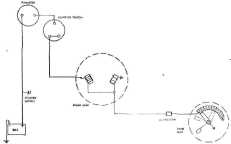1942 - 1947 CHEVROLET SHOP MANUAL
Section 12 - Electrical System
|
|
|||
|
12-29
|
|||
|
|
|||
|
If the above conditions do not prevail and current
does not pass through the reversing switch,
check the operating link and
over-travel spring for
proper assembly. If assembly is correct and trouble
still exists, replace switch.
SPARK PLUGS
The spark plugs are 10 millimeter AC-104. The
gap setting is .040". Care must
be used when installing
spark plugs to prevent upsetting the gaps
by overtightening the plugs. When
installing spark plugs,
use new gaskets and screw each plug in
finger tight, then tighten with a
wrench 1/2 to 3/4
turn beyond finger tight. If used gaskets are being
reinstalled, screw each plug in finger tight, then
tighten with a wrench 1/8
to 1/4 turn beyond finger tight.
If a tension wrench is used, the plugs should not
be tightened over 15 foot pounds
maximum.
The two important things to remember about
spark plugs are that they be kept
clean and that the gap
between the electrodes is properly adjusted. The gap should be
checked with a round feeler
gauge and set at .040".
Spark plugs have much more to do with the performance
and economy of engines than is generally
recognized.
With high combustion chamber temperatures
and the modern anti-knock fuels,
spark plugs require much
more attention because of the tendency
for oxides to deposit on the
porcelain.
This oxide is a fine, white, powdery substance which becomes impinged
upon the insulator, usually accumulating far up in the shell, but is
also deposited upon the insulator
tip.
This coating, being dry, is easily removed and
it is better to remove it when it
first forms, so that it
will not have an opportunity to accumulate and
melt into a glaze. Spark plug
cleaning, in an abrasive,
air-blast type cleaner, every 3,000 to 4,000
miles, will take care of it.
Under higher
temperatures, the white oxide becomes
fused or melted by combustion heat and
forms a smooth, glassy coating
over the insulator. An insulator in this degree of oxidation
presents the appearance of having
been coated with a heavy machine oil. It is light yellow in
color, with a hard, shiny glaze. A plug in this condition will often
perform satisfactorily when
cool, but will miss badly as soon as it becomes warmed up.
Fused oxide coating is very deceiving. Even
after an apparently thorough
cleaning, there is apt to
remain on the insulator a practically invisible
layer of oxide. The plug looks
clean, but really isn't.
The safest way to handle such plugs is to
clean them until you are
absolutely sure that they
|
are clean and then start all over and clean them
again. This coating is difficult
to remove and only a
double dose of cleaning can insure satisfactory
performance.
If spark plugs are allowed to go for 8,000 to
10,000 miles without cleaning,
the oxides will form into
blisters and the only remedy for this condition
is replacement of the plugs.
THE GASOLINE GAUGE
The gasoline gauge is composed of two units,
the indicating or dash unit
mounted on the instrument panel and the tank unit mounted in the
gasoline tank. The circuit
for this instrument passes through the ignition switch, therefore the
gasoline gauge operates
only when the ignition switch is
"on."
OPERATION
When the gasoline tank is empty, current flows
from the battery positive through
the ammeter to the
ignition switch and then to the gasoline gauge
dash unit top terminal. The
current now passes through the choke or limiting coil to the
common connection between the two
coils, which is the lower terminal on the dash unit. At this
point the current is offered two paths, one through the operating
coil of the dash unit and the other over the wire to the tank unit.
When the gasoline tank is
empty, the contact finger of the tank unit cuts out all the resistance
in the tank unit. The largest pro-
|
||
 |
|||
|
Fig. 61- Gasoline Gauge Circuits
|
|||
|
portion of the current will pass through the tank
unit circuit and only a very
small portion through the
operating coil of the dash unit, with the result
that there is not sufficient
current being forced
through this operating coil to move the hand in
the dash unit. If the gasoline
tank is half full, the
cork float of the tank unit rises on the gasoline
and moves the contact finger over
the resistance, cutting
resistance into the tank unit circuit as indicated by the lines in
Fig. 61.
|
|||
|
|
|||